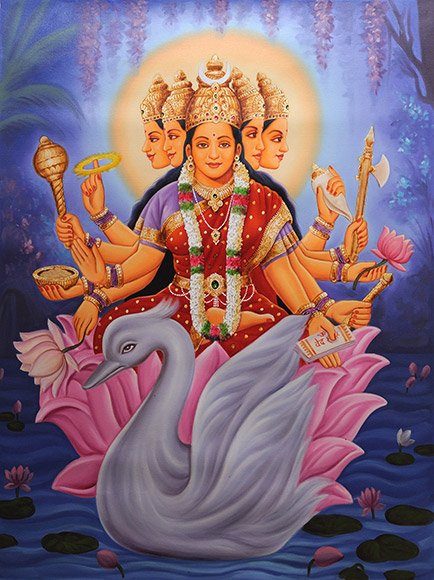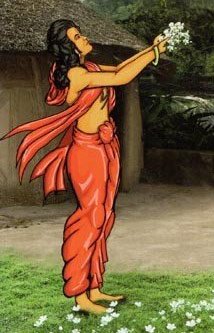Yashovarman, Yaśovarman, Yashas-varman: 7 definitions
Introduction:
Yashovarman means something in Hinduism, Sanskrit. If you want to know the exact meaning, history, etymology or English translation of this term then check out the descriptions on this page. Add your comment or reference to a book if you want to contribute to this summary article.
The Sanskrit term Yaśovarman can be transliterated into English as Yasovarman or Yashovarman, using the IAST transliteration scheme (?).
In Hinduism
Chandas (prosody, study of Sanskrit metres)
Source: Shodhganga: a concise history of Sanskrit Chanda literatureYaśovarman (यशोवर्मन्) is the name of an author of works dealing with prosodoy (chandas or chandaśśāstra) quoted by Kṣemendra (11th century) in his Suvṛttatilaka. The Suvṛttatilaka is a monumental work of Sanskrit prosody in which the author discusses 27 popular metres which were used frequently by the poets (e.g., Yaśovarman).

Chandas (छन्दस्) refers to Sanskrit prosody and represents one of the six Vedangas (auxiliary disciplines belonging to the study of the Vedas). The science of prosody (chandas-shastra) focusses on the study of the poetic meters such as the commonly known twenty-six metres mentioned by Pingalas.
Kavya (poetry)
Source: Wisdom Library: KathāsaritsāgaraYaśovarman (यशोवर्मन्) is a Kṣatriya servant of king Bahusuvarṇaka from Kautukapura according to the Kathāsaritsāgara, chapter 54. Accordingly, “... there was in old time in this country a city named Kautukapura. In it there lived a king called Bahusuvarṇaka,[14] rightly named. And he had a young Kṣatriya servant named Yaśovarman. To that man the king never gave anything, though he was generous by nature”.
The story of Yaśovarman was told by an astrologer to king Samarabāla and four others in order to demonstrate that “a smaller fortune, accompanied with enjoyment, is to be preferred to a great fortune, which, though great, is devoid of enjoyment and therefore useless”.
The Kathāsaritsāgara (‘ocean of streams of story’), mentioning Yaśovarman, is a famous Sanskrit epic story revolving around prince Naravāhanadatta and his quest to become the emperor of the vidyādharas (celestial beings). The work is said to have been an adaptation of Guṇāḍhya’s Bṛhatkathā consisting of 100,000 verses, which in turn is part of a larger work containing 700,000 verses.

Kavya (काव्य, kavya) refers to Sanskrit poetry, a popular ancient Indian tradition of literature. There have been many Sanskrit poets over the ages, hailing from ancient India and beyond. This topic includes mahakavya, or ‘epic poetry’ and natya, or ‘dramatic poetry’.
Languages of India and abroad
Sanskrit dictionary
Source: Cologne Digital Sanskrit Dictionaries: Cappeller Sanskrit-English DictionaryYaśovarman (यशोवर्मन्).—[masculine] [Name] of [several] men.
Source: Cologne Digital Sanskrit Dictionaries: Aufrecht Catalogus CatalogorumYaśovarman (यशोवर्मन्) as mentioned in Aufrecht’s Catalogus Catalogorum:—poet. Kṣemendra in Suvṛttatilaka 2, 39. 3, 21. Śp. p. 75. [Sūktikarṇāmṛta by Śrīdharadāsa] [Subhāshitāvali by Vallabhadeva] He wrote: Rāmābhyudaya nāṭaka.
Source: Cologne Digital Sanskrit Dictionaries: Monier-Williams Sanskrit-English Dictionary1) Yaśovarman (यशोवर्मन्):—[=yaśo-varman] [from yaśo > yaśas] m. Name of a king of Kanyā-kubja (who reigned about A.D, 720), [Indian Wisdom, by Sir M. Monier-Williams 499]
2) [v.s. ...] of a poet (also ma-deva), [Catalogue(s)]
3) [v.s. ...] of various other men, [Kathāsaritsāgara; Rājataraṅgiṇī]
[Sanskrit to German]
Sanskrit, also spelled संस्कृतम् (saṃskṛtam), is an ancient language of India commonly seen as the grandmother of the Indo-European language family (even English!). Closely allied with Prakrit and Pali, Sanskrit is more exhaustive in both grammar and terms and has the most extensive collection of literature in the world, greatly surpassing its sister-languages Greek and Latin.
See also (Relevant definitions)
Partial matches: Yaso, Yashas, Varman.
Full-text: Ramabhyudaya, Vakpatiraja, Yashovarmaka, Pushkaraksha, Kalapriya, Shvetapatha, Ujjain, Gopala, Bhavabhuti, Kautukapura, Arthavarman, Bhogavarman, Bahusuvarnaka.
Relevant text
Search found 16 books and stories containing Yashovarman, Yaśovarman, Yashas-varman, Yasovarman, Yaśo-varman, Yaśas-varman, Yasho-varman, Yaso-varman, Yasas-varman; (plurals include: Yashovarmans, Yaśovarmans, varmans, Yasovarmans). You can also click to the full overview containing English textual excerpts. Below are direct links for the most relevant articles:
Malatimadhava (study) (by Jintu Moni Dutta)
Part 1b - The Date of Bhavabhūti < [Chapter 1 - Introduction]
Kathasaritsagara (the Ocean of Story) (by Somadeva)
Chapter LIV < [Book IX - Alaṅkāravatī]
Gitartha Samgraha (critical Study) (by Partha Sarathi Sil)
1. Abhinavagupta and his works < [Chapter 2 - Abhinavagupta and the Gītārthasaṅgraha]
Kuntaka’s evaluation of Sanskrit literature (by Nikitha. M)
4. Gauḍavaho in Kuntaka’s treatment < [Chapter 3 - Kuntaka’s estimation of Mahākāvyas of other Poets]
13. Mahānāṭaka in Kuntaka’s treatment < [Chapter 4 - Kuntaka’s evaluation of Sanskrit Plays of other Poets]
Dasarupaka (critical study) (by Anuru Ranjan Mishra)
Part 12 - Society in the Samudramanthana < [Chapter 6 - Samavakāra (critical study)]
Part 13 - Status of Women in the Samudramanthana < [Chapter 6 - Samavakāra (critical study)]
Part 12 - Society in the Mudritakumudacandra < [Chapter 10 - Prakaraṇa (critical study)]
Hanuman Nataka (critical study) (by Nurima Yeasmin)